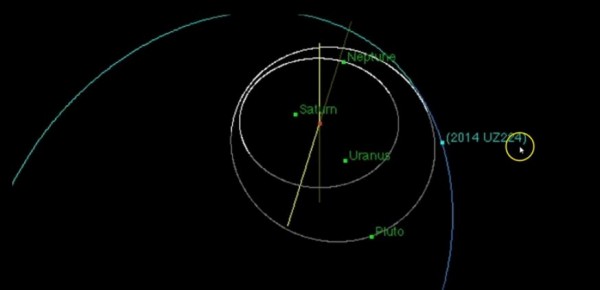By Krisana Estaura, | April 13, 2017

Researchers from the University of Michigan have spotted a spherical dim object called 'DeeDee' that is about two-thirds the size of the biggest dwarf planet in our asteroid belt. (YouTube)
Scientists have spotted a tiny planet-like object only half the size of Pluto wandering 86 billion miles away from the Earth.
Using the Atacama Large Millimeter/submillimeter Array (Alma) telescope, researchers from the University of Michigan spotted the spherical dim object which is just two-thirds the size of the biggest dwarf planet in our asteroid belt.
Like Us on Facebook
The object is essentially half the size of the planet Pluto.
The Daily Mail reported that researchers assumed the object called 2014 UZ224 or 'DeeDee' is likely to be a dwarf planet, but astronomers are yet to confirm this.
"Far beyond Pluto is a region surprisingly rich with planetary bodies," said Professor David Gerdes, a scientist with the University of Michigan.
The International Astronomical Union defines a dwarf planet as a nearly round body that orbits the sun and contains enough mass to have cleared its orbit. Scientists have so far officially identified five dwarf planets, namely Ceres, Pluto, Eris, Makemake, and Haumea.
DeeDee is short for Distant Dwarf. It has a chilly surface temperature -243°C (-406°F), and it takes 1,1000 years to orbit the sun.
"We calculated that this object would be incredibly cold, only about 30 degrees Kelvin, just a little above absolute zero," said Gerdes, who lead the team of scientists that made the discovery.
DeeDee was first spotted in 2014 through the optical Blanco telescope at the Cerro Tololo Inter-American Observatory in Chile. Astronomers, however, did not announce the discovery until last year.
At that time, astronomers were unsure of the size of the dwarf planet. The International Business Times reported that the researchers thought it might be an uncommonly large and dark object that reflected only a fraction of the light which fell on it, or a relatively small and dark one.
-
Use of Coronavirus Pandemic Drones Raises Privacy Concerns: Drones Spread Fear, Local Officials Say

-
Coronavirus Hampers The Delivery Of Lockheed Martin F-35 Stealth Fighters For 2020

-
Instagram Speeds Up Plans to Add Account Memorialization Feature Due to COVID-19 Deaths

-
NASA: Perseverance Plans to Bring 'Mars Rock' to Earth in 2031

-
600 Dead And 3,000 In The Hospital as Iranians Believed Drinking High-Concentrations of Alcohol Can Cure The Coronavirus

-
600 Dead And 3,000 In The Hospital as Iranians Believed Drinking High-Concentrations of Alcohol Can Cure The Coronavirus

-
COVID-19: Doctors, Nurses Use Virtual Reality to Learn New Skills in Treating Coronavirus Patients







